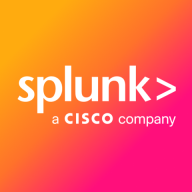![CA Digital Operational Intelligence [EOL] Logo](https://images.peerspot.com/image/upload/c_scale,dpr_3.0,f_auto,q_100,w_64/PNT6PqoKPXw9AHMYdimfVbN9.jpg)

Splunk Enterprise Security and CA Digital Operational Intelligence compete in cybersecurity intelligence and operational analytics. Splunk Enterprise Security is stronger in pricing and support, but CA Digital Operational Intelligence offers a comprehensive feature set.
Features: Splunk Enterprise Security provides advanced threat detection, investigation capabilities, and robust incident response tools. It offers real-time insights to mitigate risks. CA Digital Operational Intelligence includes dynamic service quality monitoring, predictive analytics, and comprehensive operational intelligence.
Ease of Deployment and Customer Service: Splunk Enterprise Security has straightforward deployment and extensive support resources, enhancing user experience. CA Digital Operational Intelligence has a complex setup but detailed documentation and proactive support offset it.
Pricing and ROI: Splunk Enterprise Security requires a significant initial investment, justified by high returns from comprehensive security features. CA Digital Operational Intelligence offers a cost-effective entry with strong returns, especially due to its predictive operational capabilities.

CA Digital Operational Intelligence enables IT operations teams to make smarter, faster decisions for enhancing user experience and improving IT service quality and capacity through cross-domain contextual intelligence. Built on an open, powerful engine, it is the leading advanced analytics solution in the market that provides users with comprehensive insights by ingesting and analyzing a diverse data set including metric, topology, text and log data. The machine learning–driven analytics, along with out-of-the-box visualization and correlation, helps drive a superior user experience and deliver significant operational efficiencies.
Splunk Enterprise Security is widely used for security operations, including threat detection, incident response, and log monitoring. It centralizes log management, offers security analytics, and ensures compliance, enhancing the overall security posture of organizations.
Companies leverage Splunk Enterprise Security to monitor endpoints, networks, and users, detecting anomalies, brute force attacks, and unauthorized access. They use it for fraud detection, machine learning, and real-time alerts within their SOCs. The platform enhances visibility and correlates data from multiple sources to identify security threats efficiently. Key features include comprehensive dashboards, excellent reporting capabilities, robust log aggregation, and flexible data ingestion. Users appreciate its SIEM capabilities, threat intelligence, risk-based alerting, and correlation searches. Highly scalable and stable, it suits multi-cloud environments, reducing alert volumes and speeding up investigations.
What are the key features?Splunk Enterprise Security is implemented across industries like finance, healthcare, and retail. Financial institutions use it for fraud detection and compliance, while healthcare organizations leverage its capabilities to safeguard patient data. Retailers deploy it to protect customer information and ensure secure transactions.
We monitor all IT Operations Analytics reviews to prevent fraudulent reviews and keep review quality high. We do not post reviews by company employees or direct competitors. We validate each review for authenticity via cross-reference with LinkedIn, and personal follow-up with the reviewer when necessary.